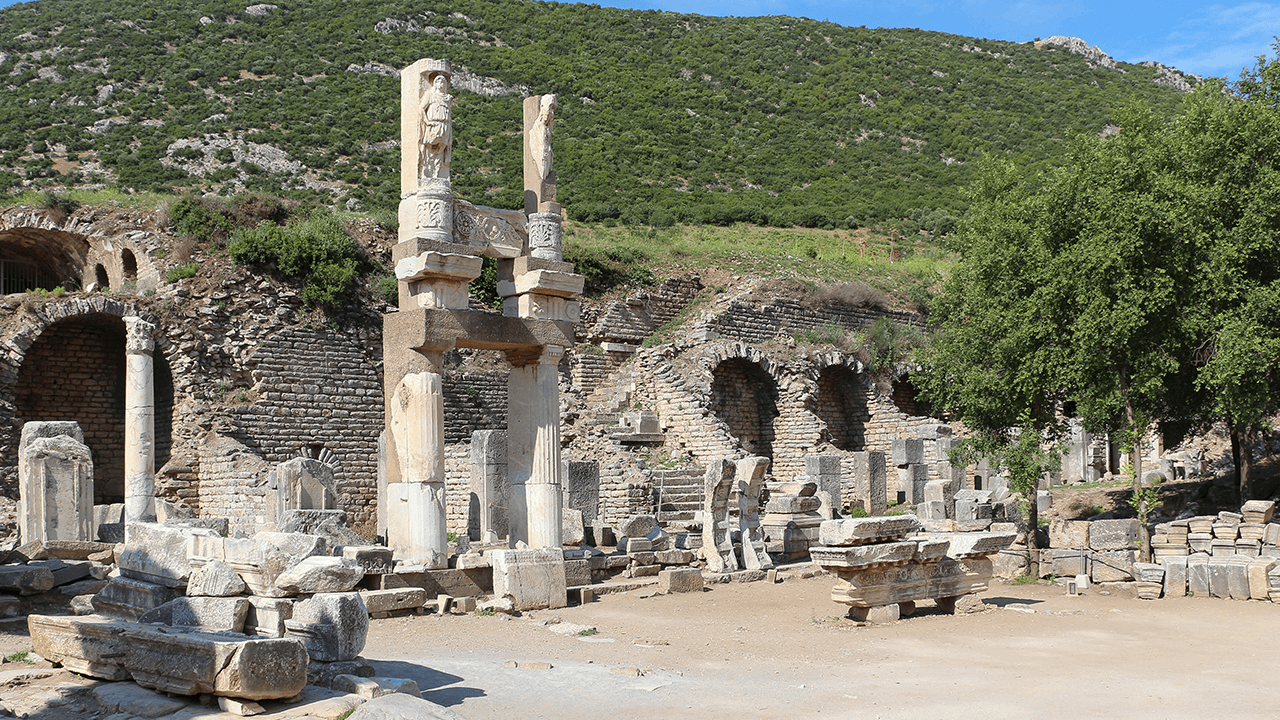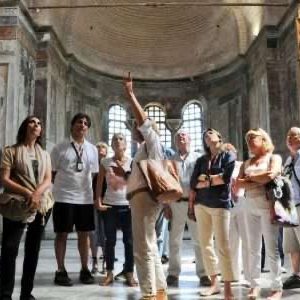Domitian Temple: The First Monument Dedicated to an Emperor in Ephesus
The Temple of Domitian, located at the southern end of Domitian Street, stands out as the first structure in Ephesus dedicated to an emperor. This majestic temple, built on a wide vaulted terrace measuring 50 x 100 meters, is a testament to imperial power and Roman architecture at its finest. Although it was originally dedicated to Emperor Domitian, the temple’s history is as complex as it is fascinating, reflecting the political and cultural changes of the era.
History and Significance of the Temple
The Temple of Domitian was constructed during the reign of Emperor Domitian, who granted Ephesus the title of “neokoros,” an honor that allowed the city to build a temple dedicated to the emperor. This status not only reinforced Ephesus’s position as one of the most important cities in the Roman Empire but also demonstrated the devotion of its inhabitants to imperial power.
The Honor of Neokoros
The title of neokoros was a privilege granted to only a few cities within the empire. This title enabled Ephesus to erect a temple for the imperial cult, solidifying its reputation as a religious and political center in Asia Minor. The Temple of Domitian was the first building in the city to hold this honor.
Design and Architecture
The temple was designed with an impressive architectural style characterized by its symmetry and proportions. The terrace on which the temple was built was supported by vaulted foundations, which can still be observed today. The northern part of the terrace was two stories high and connected by a grand staircase, also visible to this day.
Structure of the Temple
- The shorter side of the temple had eight columns.
- The longer side was adorned with thirteen columns.
- The front of the temple featured four additional columns, emphasizing its monumental entrance.
The U-Shaped Altar
On the northern side of the temple was a U-shaped altar used for religious ceremonies. This altar, a key piece of the temple, is now preserved in the Izmir Museum, where its design and details can be appreciated.
The Decline of Domitian and Dedication to Vespasian
Domitian’s reign was controversial, and his unpopularity among Romans led to his assassination by his servant. After his death, the Ephesians, fearing the loss of their neokoros status, decided to erase Domitian’s name from many inscriptions and rededicated the temple to his father, Emperor Vespasian. This change was a strategy to preserve the city’s prestige and maintain its position as an important center of the imperial cult.
The Legacy of Vespasian
Vespasian, known for his stable leadership and administrative reforms, was a more respected figure than his son. By dedicating the temple to Vespasian, the Ephesians ensured the continuity of their relationship with imperial power and demonstrated their ability to adapt to political changes.
Current State and Preservation
Although much of the Temple of Domitian has been destroyed over time, the remaining structures allow visitors to appreciate its grandeur. The columns, staircases, and vaulted foundations are a testament to the architectural skill of the Romans and the temple’s importance in the life of Ephesus.
A Monument in the Heart of Ephesus
The Temple of Domitian remains a highlight of any tour of Ephesus’s ruins. Its strategic location and unique history make it a must-see for those wishing to explore the legacy of the imperial cult in Asia Minor.
Tips for Visiting the Temple of Domitian
- Location: The temple is located at the southern end of Domitian Street, within the archaeological complex of Ephesus.
- Best time to visit: It is recommended to visit early in the morning or at sunset to avoid crowds and enjoy better lighting.
- Respect the site: As an archaeological site, it is important to avoid touching the structures and to respect protected areas.
Conclusion
The Temple of Domitian is a symbol of the power and influence of the Roman Empire in Ephesus. From its architectural design to its change of dedication, this monument tells a story of honor, controversy, and political adaptation. Visiting this temple is a unique opportunity to immerse yourself in the history of Ephesus and understand the importance of the imperial cult in ancient Rome.














3 thoughts on “Domitian Temple”
★★★★★
Looking for an authentic and enriching experience? ‘Domitian Temple’ is the place to be! Absolutely worth the visit.
★★★★★
Highly recommend visiting ‘Domitian Temple’—a site rich with history and unparalleled beauty.
★★★★★
Every moment spent at ‘Domitian Temple’ was filled with wonder and learning. It’s a place I will always cherish.